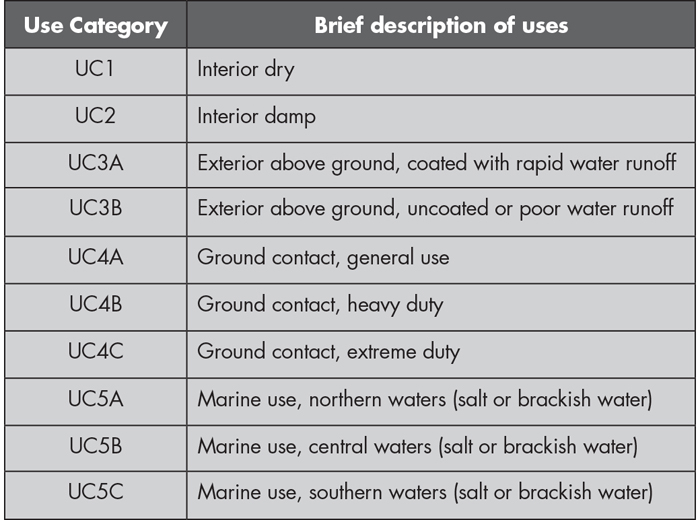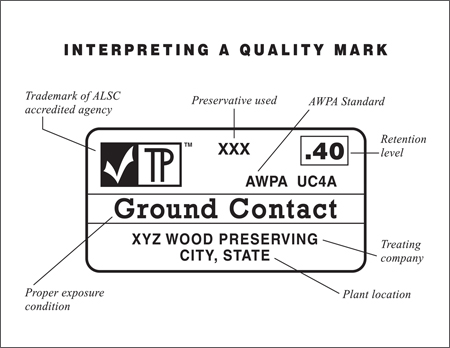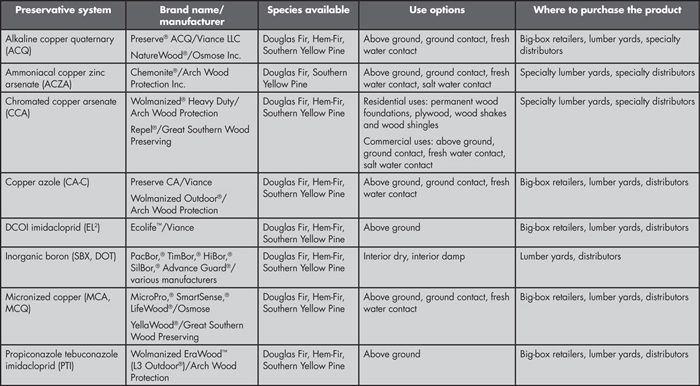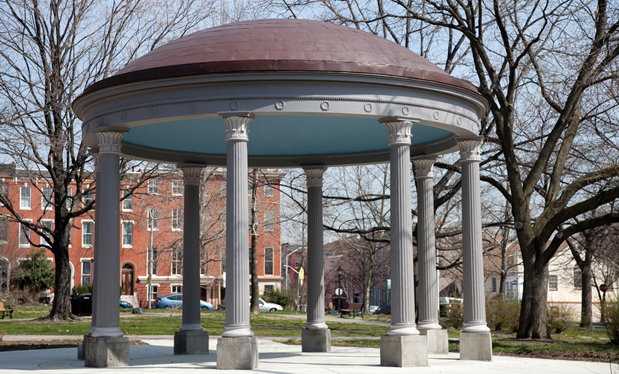Selecting appropriate fasteners when using preservative-treated wood is complicated by the variety of available preservative treatments that can be corrosive to metal fasteners.
Many preservative systems are used by preservative-treated wood manufacturers in the U.S. and Canada. Types of treated wood products available from distributors may vary depending on wood species, intended product end use, geographical area and distributor type.
For these reasons, you should be aware of options available for using preservative-treated wood and NRCA's current recommendations for using fasteners with preservative-treated wood.
Code provisions
The 2012 International Building Code® (IBC 2012) and 2012 International Residential Code® (IRC 2012) do not include provisions for the use of preservative-treated wood for roof assembly components such as blocking, nailers and roof deck sheathing or structural members supporting roof assemblies such as joists, rafters and trusses. Wood in these locations is not exposed to the weather and, therefore, not expected to be at an increased risk of decay or termite attack.
Although the codes do not specifically provide for preservative-treated wood use in roof assemblies, being familiar with the code provisions for preservative-treated wood is useful for roofing contractors. In the U.S., IBC and IRC commonly are used as the technical basis for locally adopted building codes.
For one thing, designers specifying preservative-treated wood for roof assembly construction are likely to use or reference the code language. Secondly, code provisions require preservative-treated wood and its end uses comply with specific standards that ensure properly treated wood products perform satisfactorily for their intended service conditions.
IBC 2012 defines treated wood as follows:
Fire-retardant-treated wood. Pressure-treated lumber and plywood that exhibit reduced surface-burning characteristics and resist propagation of fire.
Preservative-treated wood. Pressure-treated wood products that exhibit reduced susceptibility to damage by fungi, insects or marine borers."
Significantly, the code definition notes the preservative treatment requires a pressure-treatment process. Surface treatments, coatings, stains or paints applied to wood as protection against decay or insects are not included in the code definition. Fire-retardant-treated wood, which also is manufactured in a pressure-treatment process, is not addressed in this article.
IBC and IRC address the use of preservative-treated wood for protection against decay and termites. The codes require the use of naturally durable or preservative-treated wood in specific locations favorable for decay, fungus attack and termite infestation. Because naturally durable lumber and wood sheathing are not commonly available, preservative-treated wood is used to comply with these provisions.
The codes provide specific requirements for preservative-treated wood and the fasteners used with it. IBC 2012 provisions for treated wood are found in Chapter 23—Wood; IRC 2012 provisions are found in Chapter 3—Building Planning.
Within IBC 2012's Section 2304—General Construction Requirements, Section 2304.11 provisions identify conditions where the use of preservative-treated wood is required and mandate preservative-treated wood comply with American Wood Protection Association (AWPA) Standard U1, "Use Category System: User Specification for Treated Wood." This section lists uses where wood components are at an increased risk of decay because they are not protected from the weather, in contact with or likely to contact exposed ground, in contact with fresh water, or in contact with concrete or masonry that exposes wood to absorbed moisture or parts of floor framing close to the exposed ground in crawl spaces. Moisture content of wood exposed to these conditions may persist above 20 percent—the generally recognized threshold for wood decay.
There is one instance where IBC 2012 requires preservative-treated wood for structural roof framing. The specific provision refers to situations "when wood framing supports moisture-permeable roofs exposed to the weather such as concrete or masonry slabs." This is not a common framing condition (it is an example of awkward code language).
Section 2304.11 also requires the use of termite-resistant or preservative-treated wood "in geographical areas where hazard of termite damage is known to be very heavy" for specific structural floor construction and structural exterior framing conditions.
IRC 2012's Section R317.1 provisions for preservative-treated wood used to prevent wood decay identify conditions similar to those listed in IBC 2012 and also require preservative-treated wood comply with AWPA U1. IRC 2012, Section R318.1 calls out AWPA U1-compliant pressure-preservative-treated wood as one method of protection permitted against damage caused by termites; it is up to the adopting jurisdiction to specify the requirement for wood protection against termites.
Within IBC 2012's Section 2303—Minimum Standards and Quality, Section 2303.1.8 requires preservative-treated lumber, timber, plywood, piles and poles comply with AWPA Standard U1 and Standard M4, "Standard for the Care of Preservative-Treated Wood Products," as applicable when used as supports for permanent structures subject to the service conditions listed in Section 2304.11.
AWPA U1 designates preservative systems and retentions that have been determined to be effective for protecting wood products under specified exposure conditions. The standard is intended to help specifiers and users select treated wood products appropriate for the expected service conditions.
AWPA M4 prescribes the requirements for care of preservative-treated wood products in manufacturing plants and storage yards and on job sites. It also prescribes requirements for field fabrication, field treatment and management of used treated wood products.
IBC 2012's Section 2303.1.8 and IRC 2012's Section R317.2 provide specific requirements for identifying preservative-treated wood products with a stamped quality mark or label. The identification must be provided by a third-party inspection agency accredited by the American Lumber Standards Committee (ALSC) as part of ALSC's Treated Wood Program.
Fasteners
Provisions for fasteners and connectors in contact with preservative-treated wood are found in IBC 2012, Section 2304.9.5 and IRC 2012, Section R317.3. IBC 2012 and IRC 2012 provide similar requirements.
Hot-dipped galvanized steel, stainless steel, silicon bronze and copper fasteners, including nuts and washers, are permitted.
Hot-dipped galvanized steel fasteners compliant with ASTM A153, "Standard Specification for Zinc Coating (Hot-Dip) on Iron and Steel Hardware," are required. A153, Class C coating specification applies to fasteners more than 3/8 of an inch in diameter and washers 3/16 to 1/4 of an inch thick; the minimum average coating weight is 1.25 ounces per square foot, the equivalent of 2.1 mils. ASTM A153, Class D coating specification applies to fasteners less than 3/8 of an inch in diameter and washers less than 3/16 of an inch thick; the minimum average weight is 1 ounce per square foot, the equivalent of 1.7 mils.
For fasteners other than nails, timber rivets, wood screws and lag screws, IBC 2012 permits the use of mechanically deposited zinc-coated steel hardware that at a minimum complies with ASTM B695, "Standard Specification for Coatings of Zinc Mechanically Deposited on Iron and Steel," Class 55 specification with a minimum coating thickness of 2.1 mils. IRC 2012 does not restrict the use of mechanically deposited zinc-coated screws.
Coatings for connectors in contact with preservative-treated wood are required to be in accordance with the connector or treated wood manufacturer's recommendations or a minimum of ASTM A653, "Standard Specification for Steel Sheet, Zinc-Coated (Galvanized) or Zinc-Iron Alloy-Coated (Galvannealed) by the Hot-Dip Process," Type 185 zinc-coated galvanized steel or equivalent if no manufacturer recommendations are available. A653, Type 185 specification calls for a minimum average coating weight of 1.85 ounces per square foot for both sides of a sheet combined.
Alternatives
Provisions in IBC's and IRC's Section 104.11 allow manufacturers of wood preservative treatments and fasteners to obtain building officials' acceptance of products not specifically permitted in codes. (For more information, see "Tech Today," July 2008 issue, page 20).
A number of preservative treatment manufacturers have obtained evaluation reports by ICC Evaluation Service LLC (ICC-ES), which commonly are used to substantiate code compliance to the code authority having jurisdiction.
Standardized specifications
AWPA Standard U1 includes specifications for oil-borne and waterborne wood preservative systems.
Wood treated with oil-borne preservatives primarily is used in heavy-duty industrial and marine applications such as utility poles, pilings, glulam beams, timbers and railroad ties. Oil-borne preservatives standardized as part of AWPA Standard U1 include copper naphthenate, coal-tar creosote and pentachlorophenol. Creosote-type treatments may adversely affect wood cleanliness, odor, color, paintability and fire performance. Manufacturers of some roof membrane systems indicate their products are incompatible with oil-borne preservatives.
Wood treated with waterborne preservatives is specified for a wide variety of uses, including residential, commercial, marine, agricultural, recreational and industrial applications. Waterborne treatments are clean in appearance, odorless and paintable.
Options for AWPA U1-compliant wood for exterior construction include products treated with these waterborne preservatives: alkaline copper quaternary (ACQ-A, ACQ-C and ACQ-D); ammoniacal copper quaternary (ACQ-B); ammoniacal copper zinc arsenate (ACZA); chromated copper arsenate (CCA); and copper azole (CA-B and CA-C). Wood products treated with these formulations contain high levels of free copper and, consequently, have a tendency to corrode metal. Fasteners, anchors, connectors and flashings that contact such wood need to be of specific composition to withstand its corrosive character.
Since Jan. 1, 2004, according to AWPA, wood treated with CCA no longer is available for residential use except for CCA-treated plywood and CCA-treated wood shakes and wood shingles. CCA-treated lumber for commercial use is available from treated wood manufacturers. CCA-treated wood had been used successfully since the early 1930s and became accepted as a reliable performer when used as blocking and nailers in roof assemblies.
AWPA U1 provides specifications for non-copper-based waterborne preservative systems that have been found to not corrode metal. Wood treated with these preservatives is categorized for specific exterior or interior uses. Of these, wood treated with DCOI imidacloprid (EL2) and propiconazole tebuconazole imidacloprid (PTI) is appropriate for exterior above-ground use; wood treated with inorganic boron (SBX, DOT) is appropriate for interior use.
For field treatment of cut ends, notches and drilled holes of pressure-treated wood, AWPA Standard M4 specifies copper naphthenate solution with a minimum 2 percent copper concentration.
AWPA's Use Category System
AWPA Standard U1 provides a classification system for hazards to which wood products are exposed called the Use Category System. For each classification, AWPA provides standardized preservative treatment options with appropriate retention levels (concentrations) of preservatives measured in pounds per cubic foot of material. Each Use Category (UC) designation includes a number and may include a letter. Increasing number and letter combinations indicate increasing hazard levels of fungal decay and insect attacks.

Figure 1: AWPA Use Categories applicable to preservative-treated wood
Preservative-treated wood intended for use in exterior construction that is not in contact with the ground should be designated UC3A for coated wood and UC3B for uncoated wood or higher designations in accordance with AWPA's Use Category System (see Figure 1).
Proprietary treatments
Wood preservative formulations such as micronized copper azole (MCA), micronized copper quaternary (MCQ) and dispersed copper azole (μCA) have not been standardized by AWPA and, therefore, should be considered proprietary to each manufacturer.
Manufacturers possess evaluation reports by ICC-ES, which may be used to substantiate code compliance.
According to MCA, MCQ and μCA treatment manufacturers, wood treated with these systems contain lower overall copper levels as compared with ACQ and CA systems. The manufacturers claim MCA, MCQ and μCA are less corrosive to metal because of their lower copper concentrations.
Labeling
Quality stamps and end tags indicating wood treated with preservatives that comply with AWPA Standard U1 requirements contain the letters "AWPA" or "AWPA U1," manufacturer identification, preservative treatment designation, preservative retention level and an AWPA UC designation. AWPA U1-compliant wood pressure-treated with preservatives is inspected by ALSC-accredited third-party inspection agencies. The quality stamps and end tags include a check mark with the inspection agency's logo. Figure 2 explains how to read a quality stamp and end tag.


Figure 2: How to read an end tag and quality mark
Labels found on treated wood evaluated for code compliance in accordance with ICC-ES acceptance criteria, such as MCA-, MCQ- and μCA-treated wood, contain the ICC-ES evaluation report number and a general description of the intended application such as "Ground Contact" or "Above Ground Use."

Figure 3: Product options for preservative-treated wood
Because preservative-treated wood manufacturers go to market using brand names that typically do not include the preservative designation, it may not be easy to determine the preservative system used for a specific product. Figure 3 provides information to help make sense of the product brand names.
Guidelines for selecting fasteners
A Simpson Strong-Tie® technical bulletin "Preservative Treated Wood" points out many different pressure-preservative treatments are available, preservative retention levels vary and availability of treatments varies regionally. Simpson Strong-Tie manufactures structural connectors for wood, steel and masonry.
The bulletin provides a report about the company's testing comparing the average observed corrosiveness of several preservative wood treatments. Tested treatments were assigned ratings or relative corrosiveness with CCA-C rated at 1. ACZA was rated at greater than 3. ACQ- and CA-type treatments were rated at about 2, and MCQ corrosiveness was rated as somewhat lower than ACQ-D. Sodium borate and zinc borate treatments were rated as least corrosive at less than 1. The bulletin also provides the company's guidelines for selecting connectors, including connector coating recommendations based on use type and wood treatment type.
The Western Wood Preservers Institute (WWPI) recommends fasteners and connectors for use with treated wood comply with IBC requirements. Hardware should be hot-dipped galvanized in accordance with the standard specifications referenced in IBC Section 2304.9.5 or stainless steel. The code provides an exception for fasteners used with wood treated with inorganic boron (SBX, DOT) in interior, dry environments where plain carbon steel fasteners are acceptable. Fasteners and connectors with the same coatings should be used together. Hot-dipped galvanized steel and stainless steel should not be mixed.
For more than 60 years, WWPI has represented the interests of the preserved wood product industry throughout western North America.WWPI maintains a reference library of technical guides, research reports, consumer alerts and industry newsletters.
NRCA recommendations
NRCA suggests the following guidelines when encountering currently available preservative-treated wood:
- Hot-dipped galvanized fasteners complying with ASTM A153 and connectors complying with ASTM A653, Class G185, generally are acceptable. Type 304 or Type 316 stainless-steel fasteners and connectors are recommended for maximum corrosion resistance. Carbon steel, aluminum and electroplated galvanized steel fasteners and connectors should not be used in contact with treated wood containing copper-based preservatives.
- Fasteners with proprietary anti-corrosion coatings may be acceptable for use with treated wood. When considering the use of such proprietary coated fasteners and connectors, fastener manufacturers can be consulted for specific information regarding product performance and any precautions or special instructions that may be applicable.
- Aluminum fasteners, flashings and accessory products should not be used in direct contact with any treated wood. ACQ-treated wood is not compatible with aluminum.
- Uncoated metal and painted metal flashings and accessories, except for 300-series stainless steel, should not be used in direct contact with treated wood containing copper-based preservatives. Metal products, except stainless steel, may be used if separated from preservative-treated wood by a spacer or barrier, such as a single-ply membrane or self-adhering polymer-modified bitumen membrane.
NRCA believes the corrosion-related concerns regarding the use of available preservative-treated wood possibly outweigh the benefits such wood provides as a component in roof assemblies. In many instances, nontreated, construction-grade wood is suitable for use in roof assemblies as blocking or nailers provided reasonable measures are taken to ensure the nontreated wood remains reasonably dry when in service. When a specific design provides for a secondary means of waterproofing, NRCA considers the use of nontreated, construction-grade wood to be an acceptable substitute for treated wood.
Maciek Rupar is an NRCA director of technical services.



